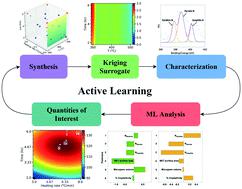当前位置:
X-MOL 学术
›
React. Chem. Eng.
›
论文详情
Our official English website, www.x-mol.net, welcomes your feedback! (Note: you will need to create a separate account there.)
Active learning-driven quantitative synthesis–structure–property relations for improving performance and revealing active sites of nitrogen-doped carbon for the hydrogen evolution reaction
Reaction Chemistry & Engineering ( IF 3.9 ) Pub Date : 2020-09-04 , DOI: 10.1039/d0re00243g Elvis Osamudiamhen Ebikade 1, 2, 3, 4, 5 , Yifan Wang 1, 2, 3, 4, 5 , Nicholas Samulewicz 1, 2, 3, 4, 5 , Bjorn Hasa 1, 2, 3, 4 , Dionisios Vlachos 1, 2, 3, 4, 5
Reaction Chemistry & Engineering ( IF 3.9 ) Pub Date : 2020-09-04 , DOI: 10.1039/d0re00243g Elvis Osamudiamhen Ebikade 1, 2, 3, 4, 5 , Yifan Wang 1, 2, 3, 4, 5 , Nicholas Samulewicz 1, 2, 3, 4, 5 , Bjorn Hasa 1, 2, 3, 4 , Dionisios Vlachos 1, 2, 3, 4, 5
Affiliation

|
While quantitative structure–property relations (QSPRs) have been developed successfully in multiple fields, catalyst synthesis affects structure and in turn performance, making simple QSPRs inadequate. Furthermore, catalysts often have multiple active sites preventing one from obtaining insights into structure–property relations. Here, we develop a data-driven quantitative synthesis–structure–property relation (QS2PRs) methodology to elucidate correlations between catalyst synthesis conditions, structural properties and observed performance and to provide fundamental insights into active sites and a systematic way to optimize practical catalysts. We demonstrate the approach to the synthesis of nitrogen-doped catalysts (NDCs) made via pyrolysis for the performance of the electrochemical hydrogen evolution reaction (HER), quantified by the onset potential and the current density. We determine crystallinity, nitrogen species type and fraction, surface area, and pore structure of the NDCs using XRD, XPS, and BET characterization. We demonstrated that an active learning-based optimization combined with various elementary machine learning tools (regression, principal component analysis, partial least squares) can efficiently identify optimum pyrolysis conditions to tune structural characteristics and performance with concomitant savings in materials and experimental time. Unlike previous reports on the importance of pyridinic or graphitic nitrogen, we discover that the electrochemical performance is not driven by a single catalyst property; rather, it arises from a multivariate influence of nitrogen dopants, pore structure and disorder in the NDC materials. Identification of active sites can help mechanistic understanding and further catalyst improvement.
中文翻译:

主动学习驱动的定量合成-结构-性质关系,以改善性能并揭示氢扩散反应中氮掺杂碳的活性位点
尽管已经在多个领域成功开发了定量结构与性质的关系(QSPR),但是催化剂的合成会影响结构并进而影响性能,从而使简单的QSPR不够。此外,催化剂通常具有多个活性位点,从而阻止人们获得对结构与性质关系的了解。在这里,我们开发了一种数据驱动的定量合成-结构-性质关系(QS 2 PRs)方法,以阐明催化剂合成条件,结构性质和观察到的性能之间的相关性,并提供对活性位点的基本见解以及优化实际催化剂的系统方法。我们证明的方法来掺杂氮的催化剂(国家数据中心)的合成制备通过热解过程中电化学氢放出反应(HER)的性能,通过起始电位和电流密度进行量化。我们使用XRD,XPS和BET表征来确定NDC的结晶度,氮物种类型和比例,表面积以及孔结构。我们证明,基于主动学习的优化与各种基本机器学习工具(回归,主成分分析,偏最小二乘)相结合,可以有效地识别最佳热解条件,以调节结构特征和性能,同时节省材料和实验时间。与以前有关吡啶氮或石墨氮重要性的报道不同,我们发现电化学性能不是由单一催化剂性质决定的。而是 它是由NDC材料中氮掺杂剂,孔结构和无序性的多方面影响引起的。识别活性位点可以帮助机械理解和进一步改进催化剂。
更新日期:2020-11-03
中文翻译:

主动学习驱动的定量合成-结构-性质关系,以改善性能并揭示氢扩散反应中氮掺杂碳的活性位点
尽管已经在多个领域成功开发了定量结构与性质的关系(QSPR),但是催化剂的合成会影响结构并进而影响性能,从而使简单的QSPR不够。此外,催化剂通常具有多个活性位点,从而阻止人们获得对结构与性质关系的了解。在这里,我们开发了一种数据驱动的定量合成-结构-性质关系(QS 2 PRs)方法,以阐明催化剂合成条件,结构性质和观察到的性能之间的相关性,并提供对活性位点的基本见解以及优化实际催化剂的系统方法。我们证明的方法来掺杂氮的催化剂(国家数据中心)的合成制备通过热解过程中电化学氢放出反应(HER)的性能,通过起始电位和电流密度进行量化。我们使用XRD,XPS和BET表征来确定NDC的结晶度,氮物种类型和比例,表面积以及孔结构。我们证明,基于主动学习的优化与各种基本机器学习工具(回归,主成分分析,偏最小二乘)相结合,可以有效地识别最佳热解条件,以调节结构特征和性能,同时节省材料和实验时间。与以前有关吡啶氮或石墨氮重要性的报道不同,我们发现电化学性能不是由单一催化剂性质决定的。而是 它是由NDC材料中氮掺杂剂,孔结构和无序性的多方面影响引起的。识别活性位点可以帮助机械理解和进一步改进催化剂。


























 京公网安备 11010802027423号
京公网安备 11010802027423号